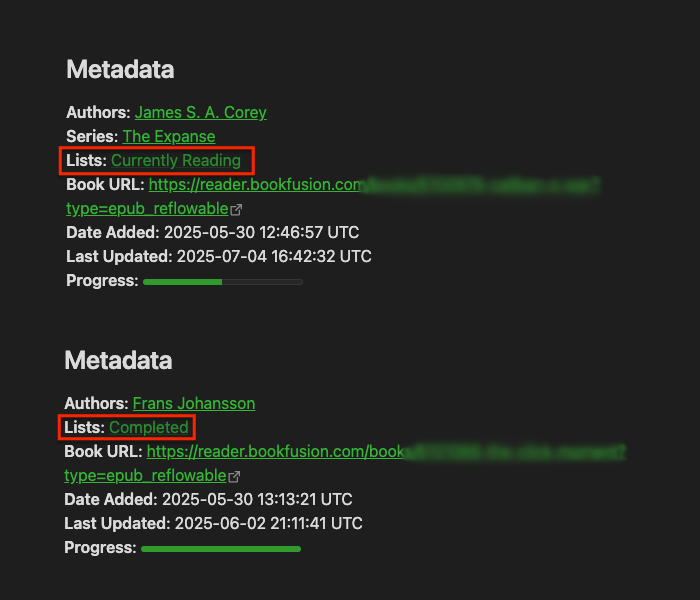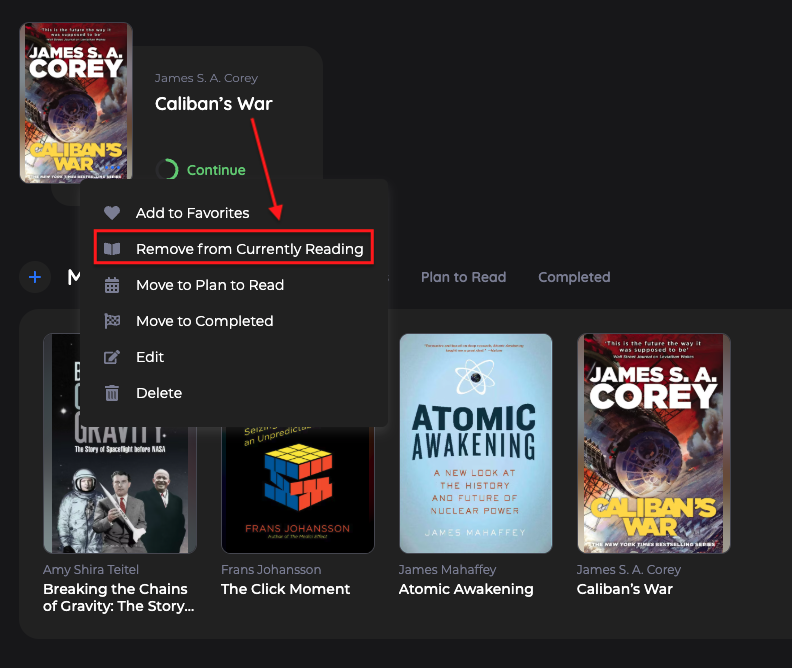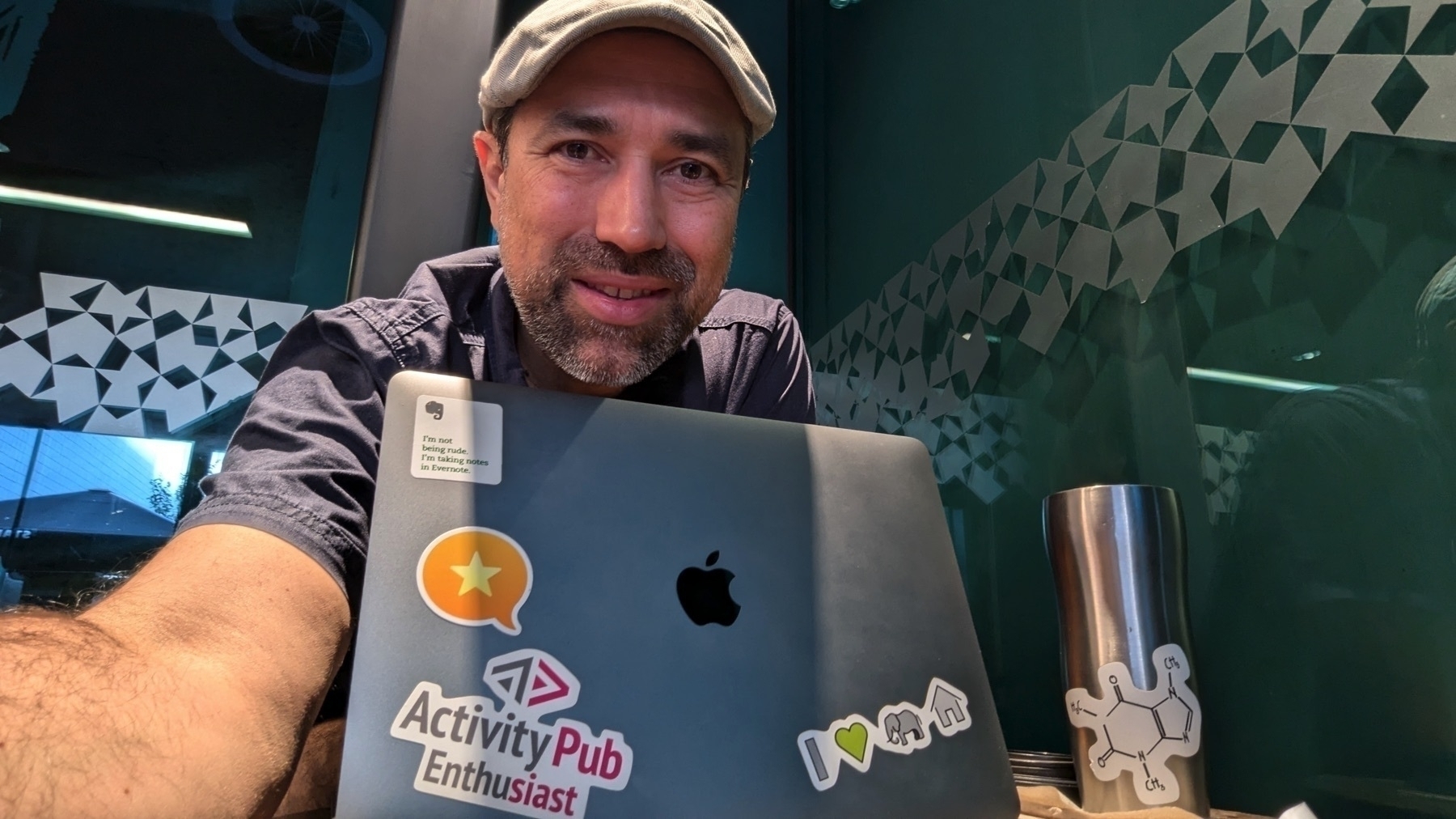Voicenotes
- Meeting note-taker with timestamps, speakers, and insights.
- Share notes with other accounts for work and personal use.
- Intelligent insights based on past notes.
- Desktop app & Chrome extension.
Tweaking some Obsidian plugins (weekend housekeeping)
Yesterday, I spent some time adjusting the settings of two Obsidian plugins — Voicenotes and BookFusion. That inevitably got me thinking about how cool it is to have apps and services automatically send information to a centralized space. What’s even cooler is that even if Obsidian ceases to exist tomorrow, all the files will still be organized and available in my computer’s file system.
BookFusion
When making some small adjustments to what I showed in a recent video, I noticed that the plugin isn’t creating “Lists” in my vault. I even went back to my video and realized that this issue was already present back then.
Anyway, if you look at the images below, you can see, by the lighter green link, that the notes “Completed” and “Currently Reading” don’t exist in my Vault. In other words, the plugin isn’t creating them, even though I have all “Index” options set to synchronize.

By the way, if you’re having trouble understanding what I’m talking about, please watch this video.
Looking at the images below from my BookFusion dashboard, you can also see that the book Caliban’s War is in the “Currently Reading” list and the three others are in the “Completed” list.


It’s possible I’m doing something wrong, but after checking all settings and not being able to figure out the problem, I decided to email the BookFusion team. I’ll update this post when I hear back from them.
Voicenotes Unofficial Plugin
I’ve been testing the Voicenotes Pages feature to produce a video about it, which is why I decided to also dedicate some time to make adjustments to the plugin settings.
Again, I’m not sure if I’m the one doing something wrong, but it looks like the variable that creates the title for the note is also including the date.
Then, there’s a suggestion. As you know, I like to have all my files in the Files folder in my Timeline, but the plugin doesn’t let us choose where to save Voicenotes attachments. My suggestion was to allow us to do that.
That’s it for this one. I just wanted to share the recent updates because, as you know, I’m always tweaking things around here.
Experimenting with Voicenotes integration into Obsidian blog
Note: Originally posted on my Voicenotes Page.
I’m using the unofficial Voicenotes plugin in Obsidian and I have it set to download everything. Not only the text but also the audio, the attachments, everything. I even have some properties that will capture links, the title, and a lot of other information.
So, I’m here thinking that maybe it is possible to create a copy of this post—that I’m adding to Voicenotes Pages—in my Obsidian blog.
Well, it’s not “maybe”, it is indeed possible because, ultimately, it’s also being created as an Obsidian note. All I have to do is set the plugin’s template to download the post and everything else but with the appropriate properties, the ones that I use to publish on Obsidian Publish.
Hmm, this is an interesting experiment. Let’s see how it goes.
Voicenotes Believer Plan, which is a single payment for life, will stop being offered at some point this week. The email they sent does not specify a date, but I just checked, and it is still available when I write this.
If you are still on the fence, this could be the perfect opportunity to buy it. And if you decide to do it, please consider using my affiliate link. You will pay the same amount, but I will receive a small commission.
The email also mentions some upcoming features that I’m really curious to try:
The problem with Evernote’s AI, is Evernote
Navigating Evernote’s AI Journey: Balancing Privacy and Functionality.
Although Evernote has gradually evolved into a more collaborative space, it has been a place for personal note-taking since its inception. Furthermore, the company has consistently emphasized its privacy-first approach throughout the years.
If we compare that to how AI normally works, I believe it is a bit difficult to create an environment that will make both pro and against AI users happy and comfortable with the app experience.

An immersive AI experience like we see on Voicenotes would mean giving the Large Language Model access to all the notes and everything in our Evernote. Some people would never accept something like this, but that is precisely how to create an outstanding experience of fully interacting with our notes and all the memories and knowledge we have saved over the years.
I appreciate the way Bending Spoons approaches this challenge by always asking permission when the topic is AI, but that means there is no complete or fully immersive experience going on. For example, as I explain in the video below, AI-Powered Search sends just a handful of notes to the LLM.
Perhaps the solution is to give users choices. Option number one would be the current one, with a pop-up constantly reminding us that part of the information is being sent to the AI model. Option two would be to add a setting that would allow us to select which notebooks can be fully scanned by AI. The other ones would be susceptible to the current opt-in system.
I believe this approach would also be useful to make the proposed chatting with Evernote to be something with a higher degree of quality in the answers.
And since I’m playing with the idea of options, why not a ‘turn off all AI’ toggle? This would disable all current and future AI features, giving skeptical users the confidence that they would never accidentally send notes to the AI Model.
What about you? Which group are you part of? Privacy first or AI superpowers?
Voicenotes describing my goodbye picture
When I asked Voicenotes to describe the picture shown in today’s video, I wasn’t expecting so many details.
As you can see below, it got very few things wrong. For example, the “I❤️🐘🏠” (I love Evernote Home) was hilariously converted to “I ❤️ 🦛”. As for the chemical structure, it is indeed caffeine, but the sticker is on my tumbler, not the laptop.
The image shows a person smiling at the camera, sitting in front of a laptop with several stickers on it. The background features a decorative wall with a geometric pattern and a window showing outside reflections. The laptop stickers include ‘I’m not being rude, I’m taking notes in Evernote’, a star icon inside a speech bubble, ‘ActivityPub Enthusiast’, ‘I ❤️ 🦛’, and a chemical structure, possibly caffeine. There is also a stainless-steel tumbler with the same chemical structure sticker.
As a side note, that is a goodbye photo. On that day, I was told that the Starbucks would be closing for a period of 18 months. Like what happened when I lived in Boston, it took me a few weeks to find the best Starbucks in Porto to take breaks from working at my office.

This one had a fairly evenly split number of local and international customers. It was never full of tourists, and, at the same time, that peaceful feeling of listening to people speak so many different languages was still present. Then there were the enjoyable conversations with many baristas who started talking to me because of the sticker with a caffeine molecule on my tumbler. One even asked me if I was a chemistry professor 😄
I’ll now have to go on a new quest to find another similar fun place. Maybe it’s the Universe’s way of reminding me that change can bring unexpected positive outcomes.
Have a lovely week, Vlad.
The case for By Me a Coffee joining the Fediverse.
If you take a look at my Buy Me a Coffee page, you’ll notice that it is basically a timeline, just like many other social media sites. In my case, perhaps because I talk a lot about it, many of the supporters are Fediverse users. Regardless of the reason, they don’t have access to certain features available to other social media users. Although this is an issue that can be easily fixed with some tweaks to the site, why stop there?
11 Million Possible Supporters
Imagine for a second that Buy Me a Coffee has adopted the ActivityPub protocol and now provides you, as a creator, with a Fediverse feed and address. Probably something like @vladcampos@buymeacoffee.com or @vladcampos@buymeacoffee.social. Or even @vladcampos@bmac.social, to shorten it like Medium did.
In any case, anyone using an ActivityPub-compatible service, like Mastodon, Flipboard, and so many others, would be able to follow your username and see and reply to all your posts from the ActivityPub service they are already using.
It means that creators who are not part of the Fediverse because they believe it is too complicated or who are not familiar with it would be exposed to 11 million users immediately. Since everything is connected, millions of users would not need a Buy Me a Coffee account to follow and engage with the posts of the creators they love.
And there’s no need to change how non-Fediverse users have access to the current Buy Me a Coffee site. For example, my blog is compatible with ActivityPub, but anyone on the open web can read the posts just like they would on any other blog.
As for the creators who are familiar with the Fediverse, they could, for example, use tools to cross-post to their Buy Me a Coffee feed. Another option would be to start using Buy Me a Coffee as their main way to interact with the rest of the Fediverse. That by itself would indirectly promote Buy Me a Coffee to other people on the Fediverse, as everyone would be seeing the company’s URL.
For some creators, this would be their first experience on the Fediverse. Others would probably move their followers to Buy Me a Coffee. In any case, being able to bring your followers with you anywhere is what makes people on the Fediverse move around and try different services. Currently, I’m a Mastodon user, but, I have already moved a couple of times and my followers always came with me.
Restricted to Creators
But instead of letting all users create ActivityPub accounts, I think Buy Me a Coffee should limit them to creators. Running an ActivityPub server is not cheap, and it comes with all sorts of moderation problems, which have caused many companies to give up. Not to mention that there’s no need to open the account creation to supporters since they can use their current Fediverse accounts to follow the creators.
First Steps
This is not a simple project, but it would certainly help Buy Me a Coffee stand out while also helping creators.
However, there are several small changes that can be accomplished with less effort. For example, show the Mastodon icon when the user sets an account on the social links. Another good practice would be to add Mastodon as an option to the “share on social media” feature. But why not create a Buy Me a Coffee Mastodon account or server to start sharing content and interacting with users there? This was the strategy adopted by Medium and Flipboard to get a sense of how things work differently on the Fediverse.
And of course, as I have already mentioned to Jijo Sunny in a recent conversation, many of the above suggestions also apply to Voicenotes.
Anyway, as I said before, I’m biased, but Mastodon is the only social media app I keep on my phone, as there are no ads or algorithms trying to make me addicted to it. I tap the app’s icon and look at my chronologically ordered feed to see and enjoy what people I choose to follow are sharing. In other words, this is the perfect environment to follow and interact with creators I support.
How Voicenotes supercharged my note-taking workflow.
Until recently, I was using the Supernote to quickly get ideas out of my head, but that has changed. I’m now double-taping the back of my Pixel and recording them on Voicenotes.
I recently published a video explaining how the app works, and you can watch it below. Basically, you record something and the AI will transcribe it. The coolest part, though, is asking anything to Voicenotes and getting answers based on your notes.
Getting contextual answers was already great, but a recently released feature brought things to another level. Now, when you open a note by tapping or clicking its title, you’ll see a list of notes related to that note.
However, that was not available when I started using Voicenotes and was trying to figure out what the app could do. One of the tests I did was record all the ideas that came to mind while I was preparing myself to have a conversation with Jijo Sunny, Voicenotes co-founder.
My original plan was to ask the app to show me a summary of my ideas for the conversation. But, days before the interview recording, when I sat down to work on the script, I decided to use the new ‘Related Notes’ feature. It blew my mind.
Because I was always starting my notes with something similar to “more ideas for my conversation with Jijo” the app easily found all the related notes. Then, it was just a matter of pasting them into Obsidian and refining everything. This process saved me so much time, when compared to how I was writing the scripts before.
The best part was that I didn’t have to go to a specific note or folder in Obsidian to write down the ideas, nor did I need to “translate” them into written sentences. It was much faster because I could just talk about any of my video ideas. The order or where the notes were didn’t matter at all. In the end, the AI did a fantastic job putting them together.
The first attempt was so successful, I decided to try the process with other scripts, and it’s working flawlessly. All I have to do is remember to include the possible title or subject of the video to help the AI group the notes in the future.
I’m still using the Supernote for many other things, but this quick capture and future refinement using Obsidian has been working too well to ignore. You can see it for yourself. One of the final results of this new workflow is shown in the video below. Almost everything I asked Jijo was captured using Voicenotes.
But keep in mind that this workflow is just one possible scenario. I’ve been seeing so many use cases. If you’re already using it, tell us how, and if not, maybe give it a try (there’s a free plan). It might surprise you.
As for the double-tap, I’m not sure if that’s available on all Android phones, but on my Pixel it is under the “Gestures” setting, and it’s called “Quick tap to start action”.
I thoroughly enjoyed this conversation and the post-recording chat, which could have easily been another podcast episode. Jijo Sunny, shares his personal journey history and how Buy Me a Coffee and Voicenotes came to be, as well as many other details. We even elaborated on the possibility of Voicenotes venturing into the Fediverse and so much more.
What if organizing has become a waste of time?
It has been a few years since I started thinking about how useful organizing actually is. Every time I see something like the AI automations for Gmail shown on the I/O 2024, I am more convinced that organizing is becoming a waste of time.
Then, there’s the recently released Voicenotes, a note-taking app that, as far as I can tell, relies on AI for transcribing, summarizing, tweeting, creating lists, telling us anything about our past, and so much more. For someone like me, that’s a bit… unsettling, to say the least. But, the younger generation may be entirely comfortable with this idea. Anyway, full review of the app coming soon.
Back to my point. It might be time to stop worrying about organizing information.